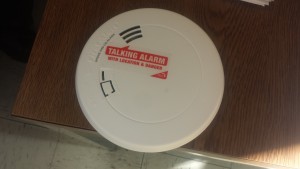WESTFIELD–The city’s fire prevention office is urging homeowners to be aware of the new smoke alarm requirements coming to the state next month.
Westfield Fire Department’s deputy chief and fire prevention officer Eric Bishop said the Massachusetts Department of Fire Services have adopted revised smoke alarm regulations for one- and two-family residences built before 1975. The new regulations will begin on Dec. 1, will affect the location and placement of smoke alarms, as well as the types that are allowed to be used and apply mostly to homeowners looking to sell or rent their dwellings. 
For placement of smoke alarms, the new regulations state that in addition to the manufacturing standards that must be followed alarms must be on every floor of a residence, including the basement.
Additionally, alarms must be placed on the ceiling at the base of every stairway, but not in the stairway itself. Also, smoke alarms must be placed on the ceiling outside of any separate sleeping area. Finally, in two-family residences, there must be smoke alarms put into each common area.
For the types of alarms used, homes that do not have hardwired smoke alarm systems must install 10-year, non-rechargeable, non-replaceable, battery-powered and sealed alarms for their homes in all the applicable locations. The new alarms must also be photoelectric, rather than ionization alarms.
In photoelectric alarms, smoke is detected through a beam of light directed at a sensor. When smoke particles enter the beam of light, they reflect the light back causing the alarm to trigger.
In ionization alarms, a small amount of radiation material–which is not considered dangerous–is within two electrically-charged areas. This combination creates ionized air, and when smoke enters the chamber it causes the alarm to trigger.
According to the Department of Fire Services, the photoelectric alarms are more effective in detecting what they call “smoldering fires,” which have been contributed to more fires that cause fatalities.
These devices can be found at most hardware and retail locations, and have a cost per alarm of approximately $25 to $100.
This may seem like a nuisance to some, or perhaps an increase in cost, but once the initial investment is made it can actually save homeowners time and money. Bishop said that regulations currently request that alarms are checked and maintained every six months to a year. With the new alarms they need changing once every 10 years.
Additionally, these new alarms will help those who may have physical difficulties checking and changing smoke alarms.
“The biggest benefit is anyone who has difficulty getting up on a ladder or stool now have to change the smoke alarms less frequently,” Bishop said.
Another option for homeowners is to invest in wireless smoke alarm systems. These systems have smoke alarms interconnected in each domicile through wireless technology, and when one alarm goes off the others do, as well. These alarms are battery-powered and can be installed as long as they are photoelectric-sensing and have batteries that last at least one year in each alarm.
These devices are a little pricier than the other option, costing about $25 to $150 per alarm.
If the installation of the alarms is successful, then prospective renters or sellers can request a home inspection from the Westfield fire prevention office. From there, a certificate will be provided if all standards are met.


